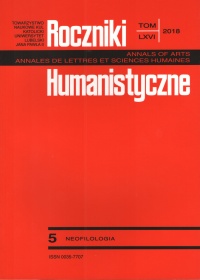Detail, Sign, Blur: Representation of the Body in Émile Zola’s Novel
Abstract
Realistic literature of the nineteenth century, striving to create the most faithful illusion of reality, comes to the limits of mimesis. The detail, which was supposed to build and give credibility to l’effet de réel, because of the excess and grotesqueness of use leading to signifié deterioration, becomes a paradoxical tool, because it undermines the foundation of the aesthetic category of realism. The aim of the article is to show that in Zola's novel, the detail does not devaluate, but on the contrary, it becomes an important element in constructing a network of meanings and a visual and rhythmic counterpoint. The use of the variable scale of perception for portraying the body detracts from the observed details and in a risky manner, for the poetics of realism, pushes the boundaries of the real world towards the invisible. The chromatic aspect of detail of the heroine’s physiognomy (signs) evidenced by Zola, testifies to the writer's intentionally constructing figurativeness into an elaborate constellation of meanings functioning both within the Les Rougon-Macquart cycle and resonating with the iconic context of the era (Courbet's painting Burial in Ornans).
References
Anderson, Mark. Kafka’s Clothes: Ornament and Aestheticisme in the Habsburg fin de siècle, New York, Oxford University Press, 1992.
Arasse, Daniel. Le Détail. Pour une histoire rapprochée de la peinture. Paris : Flammarion, 1996.
Bachelard, Gaston. La poétique de l’espace. Paris : PUF, 1978.
Batchelor, David. La peur de la couleur. [trad. P. Delcourt] Paris : Autrement, 2001.
Barthes, Roland. « Réquichot et son corps », L’obvie et l’obtus. Essais critiques III. Paris : Seuil, 1982.
Barthes, Roland. La chambre claire. Note sur la photographie. Paris : Seuil, 1980.
Belting, Hans. Pour une anthropologie des images. [trad. J. Torrent] Paris : Gallimard, 2004.
Berman Marshall. All That solide Melts Into Air. The Experience of Modernity. New York : Penguin Books, 1982.
Boisseau, Denis. « De l’« inexistence » du détail ». Licorne Hors série (1999) : 15–37.
Bourget, Paul. Essais de psychologie contemporaine, Paris : Plon, t. II, 1916.
Bourget, Paul. « Paradoxe sur la couleur ». In Les écrivains devant l’impressionnisme (éd. D. Riout), Paris, Macula, 1989.
Delacroix, Eugène. Journal. Paris : Plon, 1981.
Didi-Huberman, Georges. Ouvrir Vénus. Nudité, rêve, cruauté. L’image ouvrante 1. Paris : Gallimard, 1999.
Dufour, Philippe. Le réalisme. De Balzac à Proust. Paris : PUF, 1998.
Duchet, Claude. « Zola rouge sang ». Magazine littéraire. 413 (2002) : 45–47.
Durand,Gilbert. Les structures anthropologiques de l’imaginaire. Introduction à l’archétypologie générale. Paris : Dunod, 1984.
Flaubert, Gustave. Correspondance. Paris : Gallimard, Pléiade, t. II, 1980.
Goncourt, Jules et Edmond. Journal. Mémoires de la vie littéraire. Paris : Laffont, t. 1, 1989.
Hamon, Philippe. La description littéraire. Paris : Macula, 1991.
Louvel, Liliane. « Séduisant détail ». Licorne. Hors série (1999) : 3–12.
Matoré, Georges. Le vocabulaire des sensations dans La Curée. L’Information grammaticale. 31 (1986) : 21–26.
Speirs, Dorothy, Signori A. Dolorès. Entretiens avec Zola. Ottawa : PUO, 1990.
Stendhal, Lucien Leuwen. Paris : Le Divan, 3 vol., 1929.
Zola, Émile. La Curée. Paris : Charpentier-Fasquelle, 1895.
Zola, Émile. Nana. Paris : Fasquelle, 1962.
Zola, Émile. L’Œuvre. Paris : Charpentier, 1886.
Zola, Émile. La Terre. Paris : Charpentier, 1895.
Zola, Émile. La Bête humaine. Paris : Charpentier, 1893.
Copyright (c) 2018 Roczniki Humanistyczne

This work is licensed under a Creative Commons Attribution-NonCommercial-NoDerivatives 4.0 International License.





